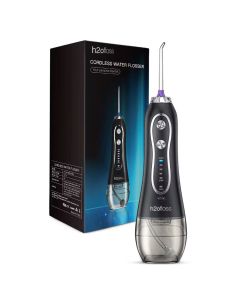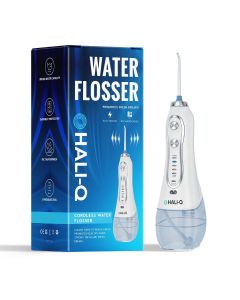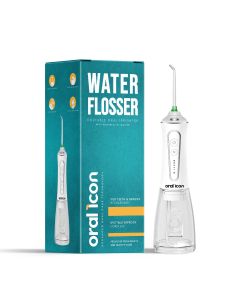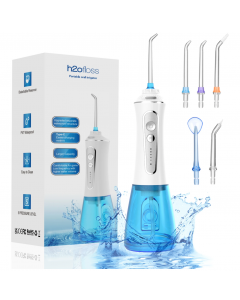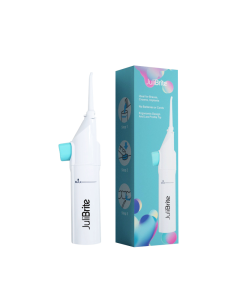Water Flosser
Is a water flosser worth it?
The answer is yes, a water flosser is absolutely worth it for your overall oral health. While the initial cost of a water flosser may be higher than traditional floss, its long-term benefits make it a worthwhile investment.
Firstly, it’s essential to realise how destructive plaque is, not only for your teeth but also for your entire mouth. Plaque is more than just a sticky film on your teeth; It's the precursor to serious dental issues like gingivitis, cavities and jawbone decay.
Brushing alone isn’t enough. While a toothbrush can clean the surface, it struggles to reach the spaces in between. Similarly, brushing your teeth alone only cleans part of your mouth, leaving hidden areas untouched.
This is why adding a water flosser to your routine is essential.
What are the benefits of using a water flosser?
- Water flossers are effective at rinsing away food particles and plaque from between the teeth. They also excel at removing bacterial growth under the gum line. This ensures a more thorough clean, giving you peace of mind about your oral health and reassurance that you're taking the best care of your teeth and gums.
- They also help rinse away any remaining toothpaste residue and can gently stimulate the gums, promoting better gum health.
- Combining brushing your teeth with water flossing allows you to maintain a healthier mouth and prevent dental problems before they start.
How often should you use a water flosser?
A water flosser is an excellent tool for maintaining oral hygiene. However, like any dental tool, it should be used correctly to avoid potential issues.
You can safely use a water flosser up to twice daily, typically once in the morning and once before bed. This routine effectively removes food particles and plaque from between your teeth and along the gum line, promoting healthier gums and teeth.
However, it's important not to overuse a water flosser, as excessive use can lead to gum damage or trauma, potentially causing gum recession. To use a water flosser safely, start on a lower pressure setting, aim the water stream at a 90-degree angle to your gum line, and move it along each tooth's base. Regular dental check-ups can provide personalised advice on incorporating a water flosser into your dental care routine.
You can use a water flosser twice daily, preferably not more often. Overuse can lead to damage or trauma to the gums, causing them to recede.
Do you use a water flosser before or after brushing?
It's recommended to use a water flosser before brushing your teeth.
Using a water flosser before brushing can significantly improve your oral hygiene routine by removing more plaque and food particles. Start by flossing to loosen these particles, then brush to clear them away. Furthermore, flossing before brushing can enhance the effectiveness of fluoride from your toothpaste. Fluoride is a crucial mineral that helps prevent cavities, and flossing first ensures more fluoride stays in your mouth, offering better protection for your teeth.
While it's ideal to floss before brushing, it's still beneficial to floss after brushing if that's your only option. Even flossing at a different time of day is better than not flossing at all.
Is electric flossing better than dental floss?
No, not necessarily. According to studies, traditional dental floss is just as effective as an oral irrigator (water flosser). However, a water flosser requires less time and effort, making it a more convenient option for many people. This ease of use often encourages more consistent flossing habits.
It's beneficial to use both tools for the best results. Dental floss can easily slip between the tight contact surfaces of the teeth, which is something a water jet can struggle with. Conversely, a water flosser excels at cleaning along the gingival margins.
Using both products together ensures your teeth are cleaned thoroughly, providing optimal oral hygiene.
What’s the best water flosser?
To find the best water flosser, look for models with the water pump housed in a separate chamber, which protects the battery from corrosion.
It's also crucial to choose a flosser that offers a soft and pulsating stream rather than a constant and hard stream to prevent gum trauma. A jet that’s too powerful can cut your gums and cause bleeding.
To help you make an informed choice, our specialists have researched and compiled a list of the top water flossers available:
#1 Oral Icon Water Flosser
The Oral Icon Water Flosser features an adjustable pulsating water jet and is highly recommended by dental specialists for its superior cleaning technique.
#2 HALI-Q Electric Water Flosser
While slightly less advanced than the Oral Icon, the wireless HALI-Q Electric Water Flosser excels in safe, effective and powerful cleaning. The IPX7 design is waterproof, so you can use it in the shower. It’s also suitable for thoroughly cleaning braces and dentures.
You can read more about our favourite top 5 water flossers in our blog post.
What’s the best water flosser for tonsil stones?
If you suffer from tonsil stones, the JuliBrite Water Flosser is ideal.
The JuliBrite is a hand-driven water flosser specifically recommended for cleaning the tonsils. It delivers a precise and gentle stream of water directly to the tonsil crypts, unlike hard water jets that can be painful for sensitive gums. JuliBrite offers a comfortable cleaning experience.
How do you clean your water flosser?
Cleaning your water flosser regularly is essential for maintaining its performance and hygiene.
One effective method is using a mouthwash, such as RyttPro Mouthwash Magic Mint, which incorporates OZ-3X technology. This technology helps thoroughly disinfect the water flosser, eliminating bacteria and preventing residue buildup.
When the tank is empty, run the engine for another five seconds to ensure the inner parts are moisture-free. After use, disconnect the water tank and attachments to allow them to dry properly.
Do dentists recommend water flossers?
Yes, dentists recommend water flossers as part of a comprehensive dental hygiene routine.
Along with brushing your teeth with a fluoride or hydroxyapatite-containing toothpaste, incorporating additional cleaning methods such as dental brushes, dental floss and water flossers can significantly enhance oral health.
However, it’s essential to choose the right type of water flosser. In our overview, you can learn how to distinguish high-quality water flossers from less effective ones, empowering you to make the best choice for your dental care and ensuring you get the best results for your oral health.
How do you use a water flosser?
Using a water flosser effectively and safely requires some basic guidelines. Here’s a step-by-step approach to get you started:
- Start with the lowest setting:
Start with the lowest water pressure setting. This will help you get used to the sensation and prevent any potential damage. High-pressure settings can cut your gums and even the insides of your cheeks or lips. - Fill the water tank:
Fill the water flosser’s tank with lukewarm water. You can also add a small amount of mouthwash for additional cleaning power and freshness. - Proper positioning:
Lean over the sink to avoid splashing, and place the tip of the flosser in your mouth. Close your lips slightly to prevent water from splattering, but allow the water to flow out of your mouth into the sink. - Aim at the gumline:
Aim the water stream at a 90-degree angle to your gumline. Move the tip along your gumline and between your teeth, pausing briefly between each tooth to ensure a thorough clean. - Use a gentle motion:
Use a gentle, sweeping motion to guide the flosser along your teeth and gums. Avoid pressing the tip too hard against your gums. - Adjust the pressure gradually:
Once you’re comfortable, you can gradually increase the water pressure to a level that feels effective but still comfortable. Never use the highest setting immediately, as it can be too harsh. - Focus on all areas:
Make sure to clean both the front and back of your teeth, as well as the areas around braces, bridges or other dental work. - Finish up:
After flossing, empty the water tank and run the flosser for a few seconds to remove any remaining water. This helps prevent bacterial buildup and keeps your device clean.
By following these steps, you can maximise the benefits of your water flosser while maintaining optimal dental health.
Regular use, combined with brushing and other dental hygiene practices, can help keep your smile bright and your gums healthy.
The information contained within this blog is not intended as a substitute for professional dental advice, so always consult your dentist for the best advice for your specific oral health needs.


